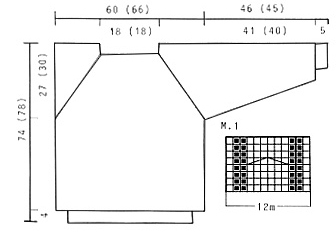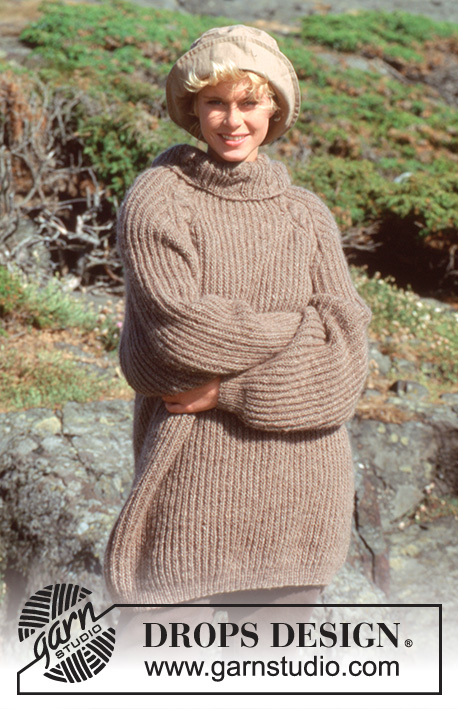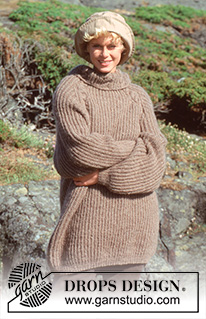Comments / Questions (11)
![]() Claire Lafrance wrote:
Claire Lafrance wrote:
Il me reste 104m. lorsque je tricote toutes les mailles sur 11cm je fais seulement des fausses côtes anglaises? je ne tiens plus compte des mailles endroits, mailles envers du modèle 1 sans faire de torsade sur le 1er 11cm?
13.12.2019 - 14:51DROPS Design answered:
Bonjour Mme Lafrance, vous tricotez les 104 m comme avant pendant 11 cm, puis vous inversez le motif pour que les fausses côtes anglaises et les torsades soient visibles sur l'endroit quand on va replier le col. Bon tricot!
13.12.2019 - 15:56
![]() Claire Lafrance wrote:
Claire Lafrance wrote:
Pour faire mes diminutions au début modèle 1: je prends la maille avant mod.1 et la 1ere maille de mod 1 et je les tricote ensemble. À la fin des 12mailles je ne comprends pas comment faire la diminution surtout que le rang se termine avec 12mailles de modèle 1 je ne sais pas où aller chercher la maille que je dois faire glisser Merci de me revenir
06.12.2019 - 02:40DROPS Design answered:
Bonjour Mme Lafrance, pour diminuer avant le diagramme M.1, vous tricotez la mailles avant M.1 + la 1ère m de M.1 ensemble à l'endroit, vous tricotez les 10 mailles suivantes de M.1 (= 2 m env, 6 m end (ou torsade), 2 m env), glissez la dernière m de M.1 à l'end, tricotez la m suivante, passez la maille glissée par-dessus la maille tricotée = vous avez toujours bien 12 m pour M.1. Bon tricot!
06.12.2019 - 08:48
![]() Claire Lafrance wrote:
Claire Lafrance wrote:
Je suis rendue à mettre toutes mes mailles sur la même broche. Si j'ai bien compris, sur la broche je retrouve dans cet ordre: 1 manche, le dos, le devant et l'autre manche. Avant de mettre toutes les mailles sur la même broche j'avais terminé par un rang sur l'endroit du travail. Je commence l'empiècement avec un rang endroit donc j'ai 2 rangs endroits d'affilée? Je termine le rang avec M.1 comment faire la diminution de la 12ième maille?
05.12.2019 - 13:32DROPS Design answered:
Bonjour Mme Lafrance, l'empiècement commence après la manche droite (et non gauche, correction faite ), juste avant le dos = à la transition entre la manche droite et le dos, autrement dit: dos, manche gauche, devant, manche droite. Il vaut mieux que vous tricotiez un rang sur l'envers sur chacune des pièces, ansi le 1er rang de l'empiècement se fera sur l'endroit - en commençant par le dos - vous tricoterez ensuite en allers et retours, en commençant sur l'endroit. Bon tricot!
05.12.2019 - 14:18
![]() Johanne wrote:
Johanne wrote:
Effectivement il y a une erreur dans l'explication, en danois et en français. les côtes anglaises se tricotent 1 jetée, 1 m glissée, 1 m endroit, donc jamais de maille envers. Si vous essayez de faire l'échantillon avec l'explication d'origine, vous allez vous apercevoir du problème. Je tricote en Alpaca bleu marin et KidSilk bleu cobalt. ça rend bien.
16.04.2019 - 15:01
![]() Catherine Charles wrote:
Catherine Charles wrote:
Merci pour votre réponse, encore juste une petite précision s’il vous plaît, une fois que j’ai mis toutes les mailles sur l’aiguille circulaire no 6, on est bien d’accord que je ne vais pas tricoter en rond mais arrivée au bout du rang je tourne le tricot et je tricote de l’autre côté ? Donc un côté endroit et un côté envers comme pour le dos, devant et manches ? Merci de votre réponse ! Meilleures salutations, Catherine Charles
13.07.2018 - 17:46DROPS Design answered:
Bonjour Mme Charles, tout à fait, l'empiècement ne se tricote pas en rond mais bien en rangs (= en aller-retour), le 1er rang de M.1 se fait sur l'endroit pour que la torsade tombe également sur l'endroit. Bon tricot!
16.07.2018 - 08:10
![]() Catherine Charles wrote:
Catherine Charles wrote:
Bonjour, je ne comprends pas les instructions pour l’empiècement du modèle Drops 40-11, est-ce que vous pourriez m’aider ? Faut-il rabattre 6 mailles sous la manche, et pourquoi monter 6m en fin de rang ? Si on tricote en aller/retour sur l’aiguille no 6 et que M1 se trouve à la fin, comment ensuite diminuer une maille avant M1 ? Bref je suis un peu perdue et j’apprécierais beaucoup une aide. Merci d’avance Catherine
13.07.2018 - 09:58DROPS Design answered:
Bonjour Mme Charles, au début de l'empiècement, on rabat les 6 premières m du dos (= il reste 74 m pour le dos, cette info manquait, la correction est faite) et on monte 6 m à la fin du rang pour pouvoir tricoter M.1 sur les 6 dernières m de la manche + les 6 nouvelles mailles. Bon tricot!
13.07.2018 - 12:40
![]() Catherine Charles wrote:
Catherine Charles wrote:
Bonjour, les explications des côtes anglaises pour ce modèle sont fausses, elles ont dûs être mal traduites, il n’y a pas de maille envers du tout dans les côtes anglaises: 1er tour : 1 jeté, maille glissée à l’envers et une maille à l’endroit. 2ème tour : tricoter ensemble le jeté et la maille glissée, un jeté et glisser une maille à l’envers, Etc...
11.07.2018 - 22:11DROPS Design answered:
Bonjour Mme Charles, merci pour votre retour, la traduction française correspondant à la version originale, nos stylistes vont vérifier ces côtes. Bon tricot!
12.07.2018 - 09:28
![]() Kphli Therese wrote:
Kphli Therese wrote:
Besten Dank für die Antwort. Aber ich bin noch nicht weiter. In der Anleitung der Passe steht: 6 M abk., 82 M Patent (Rückenteil), M1, 72 M Patent (linker Aermel), 82 M Patent (Vorderteil), M1, 72 M Patent (rechter Aermel), M1, gleichzeitig am Schluss der R 6 Masche anschlagen, d.h. diese brauche ich um M1 mit 12 M. Bin also am Ende der Reihe. Da für den Raglan beidseitig abgenommen werden muss: wo nehme ich die M her für die Abnahme? Danke
13.03.2016 - 08:10DROPS Design answered:
Guten Tag Therese, die Maschen für die Raglanabnahme nehmen Sie von Vorder- und Rückenteil und von den Ärmeln (nicht aus der Raglanlinie) - am Reihenanfang und -ende können Sie selbstverständlich nicht beidseitig abnehmen, aber Anfang und Ende zusammen ergeben auch wieder eine beidseitige Abnahme.
14.03.2016 - 08:32
![]() Kohli Therese wrote:
Kohli Therese wrote:
Zu Modell 40-11: Ich komme mit der Passé nicht vorwärts und meine Fragen an meinen Wollladen wurden auch nicht zu meiner Zufriedenheit beantwortet. Darf ich um die Überprüfung der Anleitung bitten. Mein Problem ist hauptsächlich wo werden die 4 x M1 (Raglan) gestrickt. Für eine Abklärung wäre ich sehr dankbar.
13.01.2016 - 14:19DROPS Design answered:
Liebe Therese, ich bin nicht ganz sicher, ob ich Ihre Frage verstehe: M1 ist das Zopfmuster an der Raglanlinine und dort wird es auch gestrickt.
02.03.2016 - 10:00
![]() Traci Almash-smith wrote:
Traci Almash-smith wrote:
Where are the directions to include the cable??
27.10.2012 - 01:30DROPS Design answered:
Dear Mrs Tracy Almash-smith, you will find at the very bottom of the pattern theh diagram M.1 for the cable and all instructions under yoke. Happy Knitting!
14.11.2012 - 09:51
The Big Cozy |
||||||||||
 |
 |
|||||||||
DROPS jumper with cables and false English rib in “Alpaca” and "Kid Silk". Long or short version. Size S – L.
DROPS 40-11 |
||||||||||
|
False English rib: Row 1, WS: * 1 YO, slip 1 st as if to P, P1 *, repeat from *-*. Row 2, RS: * K1, work YO and slipped P st tog *, repeat from *-*. Repeat row 1 and 2. Rib: * K1, P1 *, repeat from *-*. Cable pattern: See diagram. The diagram shows the pattern from the RS. Short version: Cast on 6 less sts and inc 6 additional sts after the rib = 86-94 sts. Dec measurements for armhole by 16-18 cm / 6 1/7"-7". Finished length = 58-60 cm / 22¾"-23½". ______________________________ Front piece: With 1 strand of each yarn cast on 86-94 sts - for short version, see above – (includes 1 edge st each side for seam) on pointed needles size 3.5 mm / US 4 and work 4 cm / 1½" Rib. Change to needle size 6 mm / US 10 and continue in false English rib with 1 edge st each side – make sure to have the K st in false English rib over the K st in rib. REMEMBER THE GAUGE! When piece measures 47-48 cm / 18½"-19" put piece aside and knit the back piece. Back piece: Cast on and work like front piece. Sleeve: With 1 strand of each yarn cast on 36-38 sts (includes 1 edge st each side for seam) on pointed needles size 3.5 mm / US 4 and work 5 cm / 2" Rib. Change to needle size 6 mm / US 10 and continue in false English rib with 1 edge st each side – make sure to have the K st in false English rib over the K st in rib. At the same time inc 1 st each side inside the edge st on every 5th row for size S/M and on * every 4th and 5th row * alternately for size M/L a total of 21-23 times = 78-84 sts. When piece measures 46-45 cm / 18"-17¾" put it aside and knit the other sleeve. Yoke: Now slip all sts from body pieces and sleeves on the same circular needle size 6 mm / US 10 = 328-356 sts and complete jumper back and forth on needle from transition between right sleeve and back piece. Work first row as follows: bind off 6 sts, work 74-82 sts in false English rib (= back piece), M.1, 66-72 sts in false English rib (= left sleeve), M.1, 74-82 sts in false English rib (= front piece), M.1, 66-72 sts in false English rib (= right sleeve), M.1, and cast on 6 new sts at the end of row. Now dec 1 st on each side of each repeat of M.1 (= 8 dec per row) on every other row a total of 29-32 times on sleeves and 27-31 times on body pieces as follows: Before M.1: K tog the st before M.1 and the first st in M.1 (this st replaces the first st in M.1). After M.1: slip the last st in M.1 as if to K, K 1, psso (this st replaces the last st in M.1). When all dec are complete there are 104-104 sts left on row. Continue in pattern as before on all sts for 11 cm / 4½" and now continue in reverse false English rib and cable pattern (WS becomes RS!) as follows from RS: 20 sts in false English rib, M.1, 8 sts in false English rib, M., 4 sts in false English rib, M.1, 4 sts in false English rib, M.1, 8 sts in false English rib, M.1. When the piece in reverse pattern measures 15 cm / 6" bind off all sts. Assembly: Sew tog M.1 and back piece. Sew sleeve seams. |
||||||||||
Diagram explanations |
||||||||||
|
||||||||||

|
||||||||||
Have you finished this pattern?Tag your pictures with #dropspattern or submit them to the #dropsfan gallery. Do you need help with this pattern?You'll find 21 tutorial videos, a Comments/Questions area and more by visiting the pattern on garnstudio.com. © 1982-2025 DROPS Design A/S. We reserve all rights. This document, including all its sub-sections, has copyrights. Read more about what you can do with our patterns at the bottom of each pattern on our site. |
||||||||||



































































Post a comment to pattern DROPS 40-11
We would love to hear what you have to say about this pattern!
If you want to leave a question, please make sure you select the correct category in the form below, to speed up the answering process. Required fields are marked *.